Business Environment: Economic, Political, and Social Factors Report
VerifiedAdded on 2020/06/06
|9
|2995
|26
Report
AI Summary
This report provides a detailed analysis of the business environment, focusing on two contrasting businesses: Marks and Spencer (M&S) and the National Health Service (NHS). It begins by describing the type, purpose, and ownership of each business, highlighting M&S as an international public limited company in the tertiary sector and the NHS as a national not-for-profit public entity. The report then identifies and describes the stakeholders influencing each business, including customers, employees, and suppliers. The organizational structures of both businesses are examined, comparing hierarchical and flat structures and their impact on fulfilling business purposes. Furthermore, the report explores the influence of economic environments, such as booms and recessions, on business activities. Finally, it assesses the impact of political, legal, and social factors on the business activities of M&S, emphasizing the importance of political stability, legal compliance, and social considerations. The report concludes by summarizing the key findings and their implications for business success.
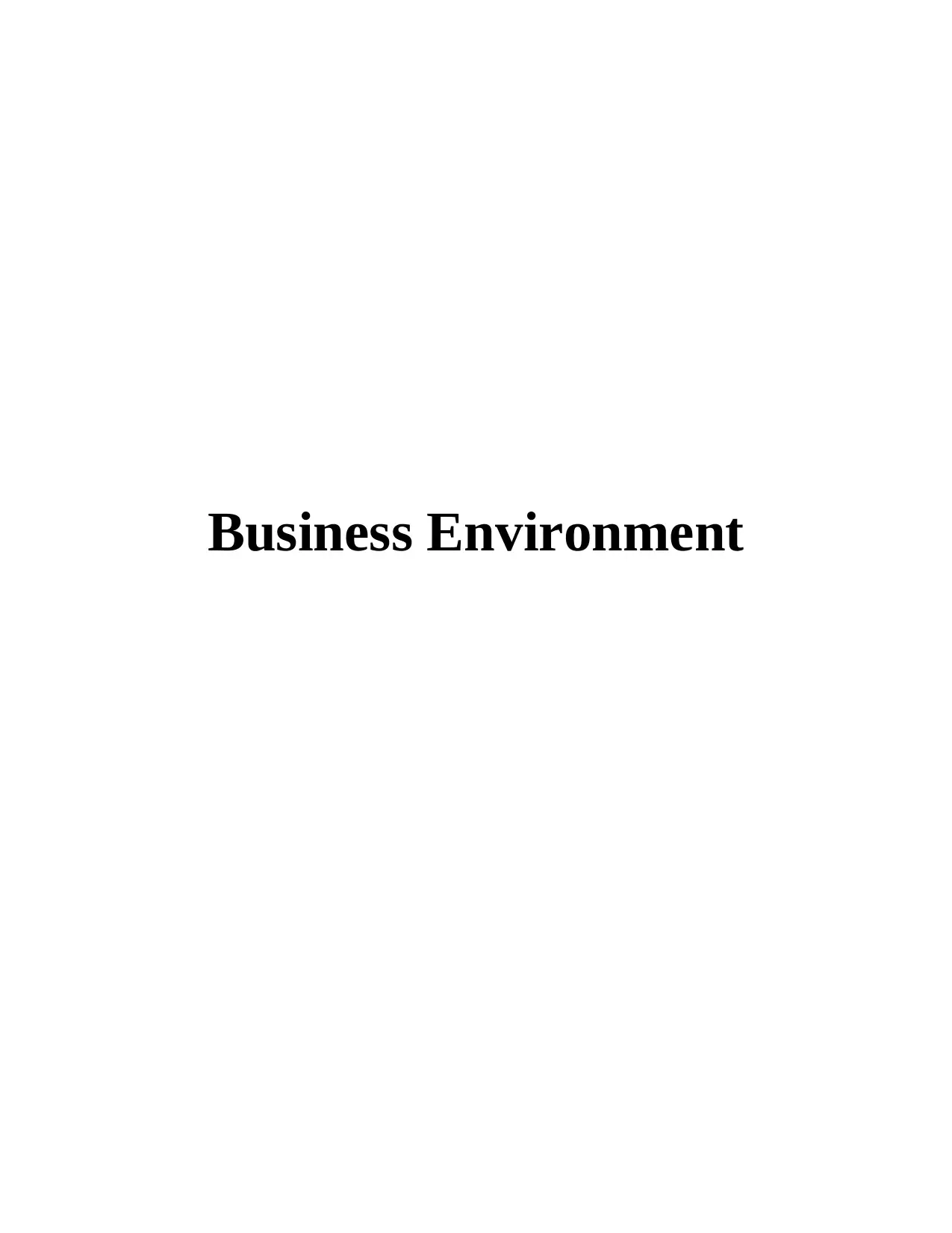
Business Environment
Paraphrase This Document
Need a fresh take? Get an instant paraphrase of this document with our AI Paraphraser
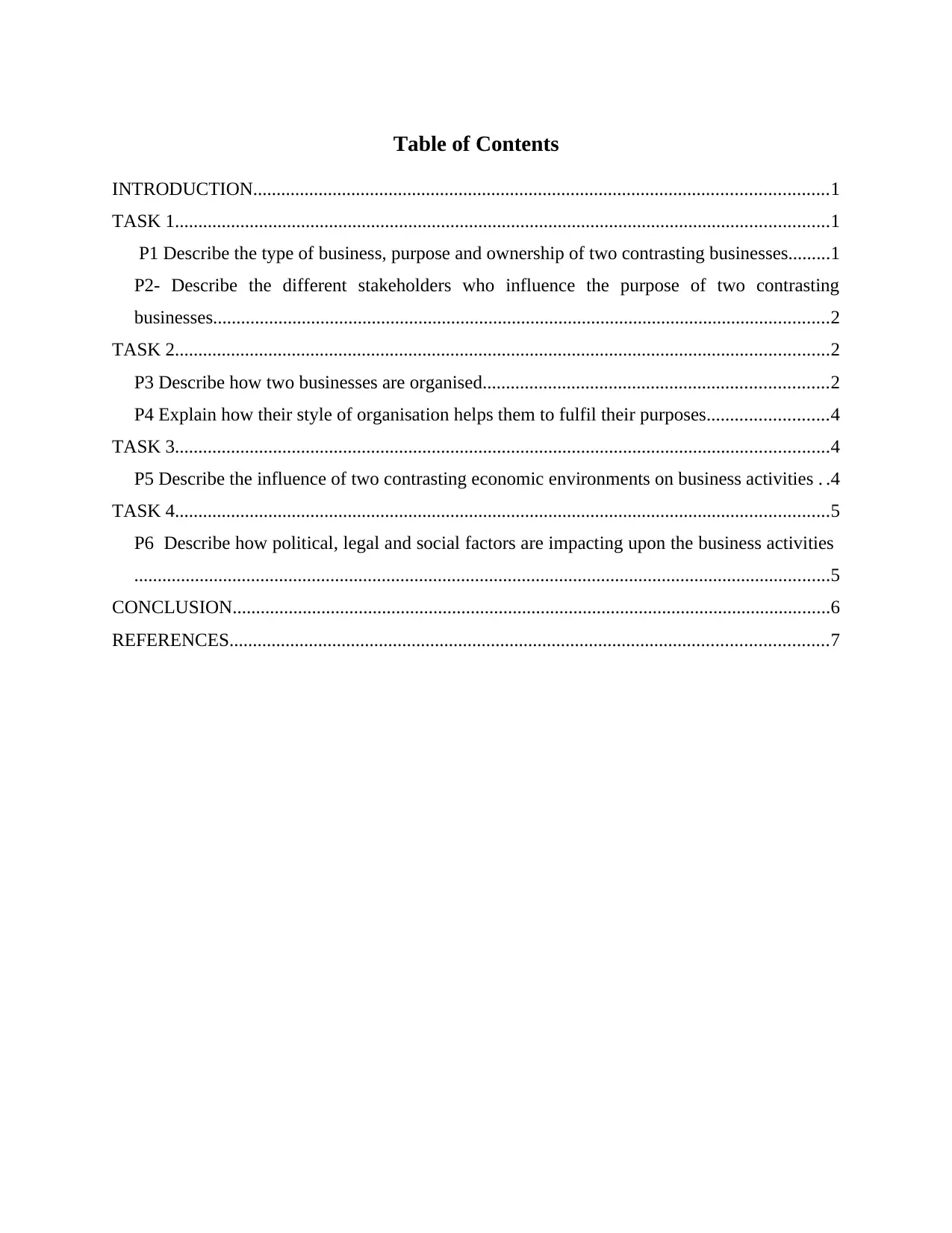
Table of Contents
INTRODUCTION...........................................................................................................................1
TASK 1............................................................................................................................................1
P1 Describe the type of business, purpose and ownership of two contrasting businesses.........1
P2- Describe the different stakeholders who influence the purpose of two contrasting
businesses....................................................................................................................................2
TASK 2............................................................................................................................................2
P3 Describe how two businesses are organised..........................................................................2
P4 Explain how their style of organisation helps them to fulfil their purposes..........................4
TASK 3............................................................................................................................................4
P5 Describe the influence of two contrasting economic environments on business activities . .4
TASK 4............................................................................................................................................5
P6 Describe how political, legal and social factors are impacting upon the business activities
.....................................................................................................................................................5
CONCLUSION................................................................................................................................6
REFERENCES................................................................................................................................7
INTRODUCTION...........................................................................................................................1
TASK 1............................................................................................................................................1
P1 Describe the type of business, purpose and ownership of two contrasting businesses.........1
P2- Describe the different stakeholders who influence the purpose of two contrasting
businesses....................................................................................................................................2
TASK 2............................................................................................................................................2
P3 Describe how two businesses are organised..........................................................................2
P4 Explain how their style of organisation helps them to fulfil their purposes..........................4
TASK 3............................................................................................................................................4
P5 Describe the influence of two contrasting economic environments on business activities . .4
TASK 4............................................................................................................................................5
P6 Describe how political, legal and social factors are impacting upon the business activities
.....................................................................................................................................................5
CONCLUSION................................................................................................................................6
REFERENCES................................................................................................................................7
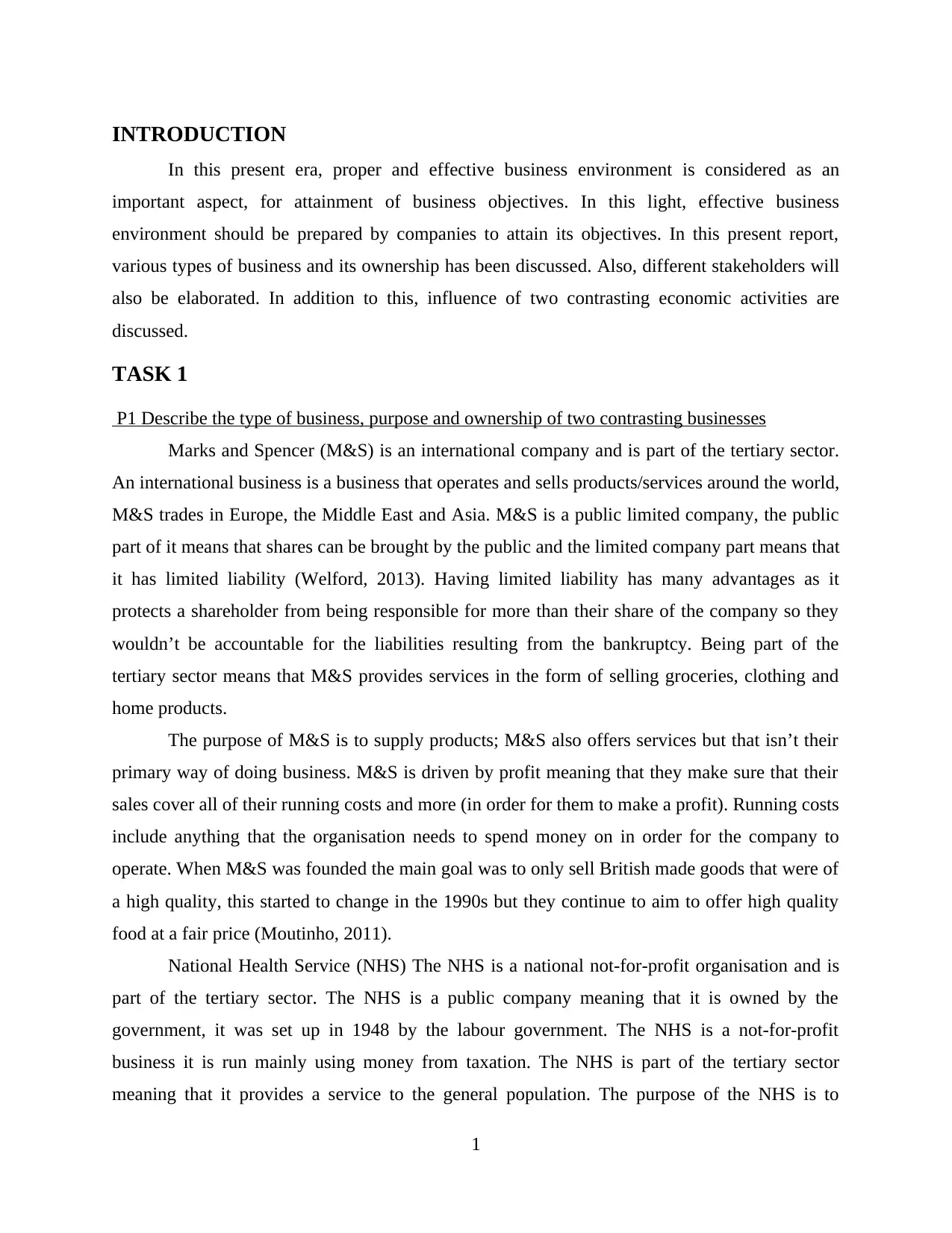
INTRODUCTION
In this present era, proper and effective business environment is considered as an
important aspect, for attainment of business objectives. In this light, effective business
environment should be prepared by companies to attain its objectives. In this present report,
various types of business and its ownership has been discussed. Also, different stakeholders will
also be elaborated. In addition to this, influence of two contrasting economic activities are
discussed.
TASK 1
P1 Describe the type of business, purpose and ownership of two contrasting businesses
Marks and Spencer (M&S) is an international company and is part of the tertiary sector.
An international business is a business that operates and sells products/services around the world,
M&S trades in Europe, the Middle East and Asia. M&S is a public limited company, the public
part of it means that shares can be brought by the public and the limited company part means that
it has limited liability (Welford, 2013). Having limited liability has many advantages as it
protects a shareholder from being responsible for more than their share of the company so they
wouldn’t be accountable for the liabilities resulting from the bankruptcy. Being part of the
tertiary sector means that M&S provides services in the form of selling groceries, clothing and
home products.
The purpose of M&S is to supply products; M&S also offers services but that isn’t their
primary way of doing business. M&S is driven by profit meaning that they make sure that their
sales cover all of their running costs and more (in order for them to make a profit). Running costs
include anything that the organisation needs to spend money on in order for the company to
operate. When M&S was founded the main goal was to only sell British made goods that were of
a high quality, this started to change in the 1990s but they continue to aim to offer high quality
food at a fair price (Moutinho, 2011).
National Health Service (NHS) The NHS is a national not-for-profit organisation and is
part of the tertiary sector. The NHS is a public company meaning that it is owned by the
government, it was set up in 1948 by the labour government. The NHS is a not-for-profit
business it is run mainly using money from taxation. The NHS is part of the tertiary sector
meaning that it provides a service to the general population. The purpose of the NHS is to
1
In this present era, proper and effective business environment is considered as an
important aspect, for attainment of business objectives. In this light, effective business
environment should be prepared by companies to attain its objectives. In this present report,
various types of business and its ownership has been discussed. Also, different stakeholders will
also be elaborated. In addition to this, influence of two contrasting economic activities are
discussed.
TASK 1
P1 Describe the type of business, purpose and ownership of two contrasting businesses
Marks and Spencer (M&S) is an international company and is part of the tertiary sector.
An international business is a business that operates and sells products/services around the world,
M&S trades in Europe, the Middle East and Asia. M&S is a public limited company, the public
part of it means that shares can be brought by the public and the limited company part means that
it has limited liability (Welford, 2013). Having limited liability has many advantages as it
protects a shareholder from being responsible for more than their share of the company so they
wouldn’t be accountable for the liabilities resulting from the bankruptcy. Being part of the
tertiary sector means that M&S provides services in the form of selling groceries, clothing and
home products.
The purpose of M&S is to supply products; M&S also offers services but that isn’t their
primary way of doing business. M&S is driven by profit meaning that they make sure that their
sales cover all of their running costs and more (in order for them to make a profit). Running costs
include anything that the organisation needs to spend money on in order for the company to
operate. When M&S was founded the main goal was to only sell British made goods that were of
a high quality, this started to change in the 1990s but they continue to aim to offer high quality
food at a fair price (Moutinho, 2011).
National Health Service (NHS) The NHS is a national not-for-profit organisation and is
part of the tertiary sector. The NHS is a public company meaning that it is owned by the
government, it was set up in 1948 by the labour government. The NHS is a not-for-profit
business it is run mainly using money from taxation. The NHS is part of the tertiary sector
meaning that it provides a service to the general population. The purpose of the NHS is to
1
⊘ This is a preview!⊘
Do you want full access?
Subscribe today to unlock all pages.

Trusted by 1+ million students worldwide
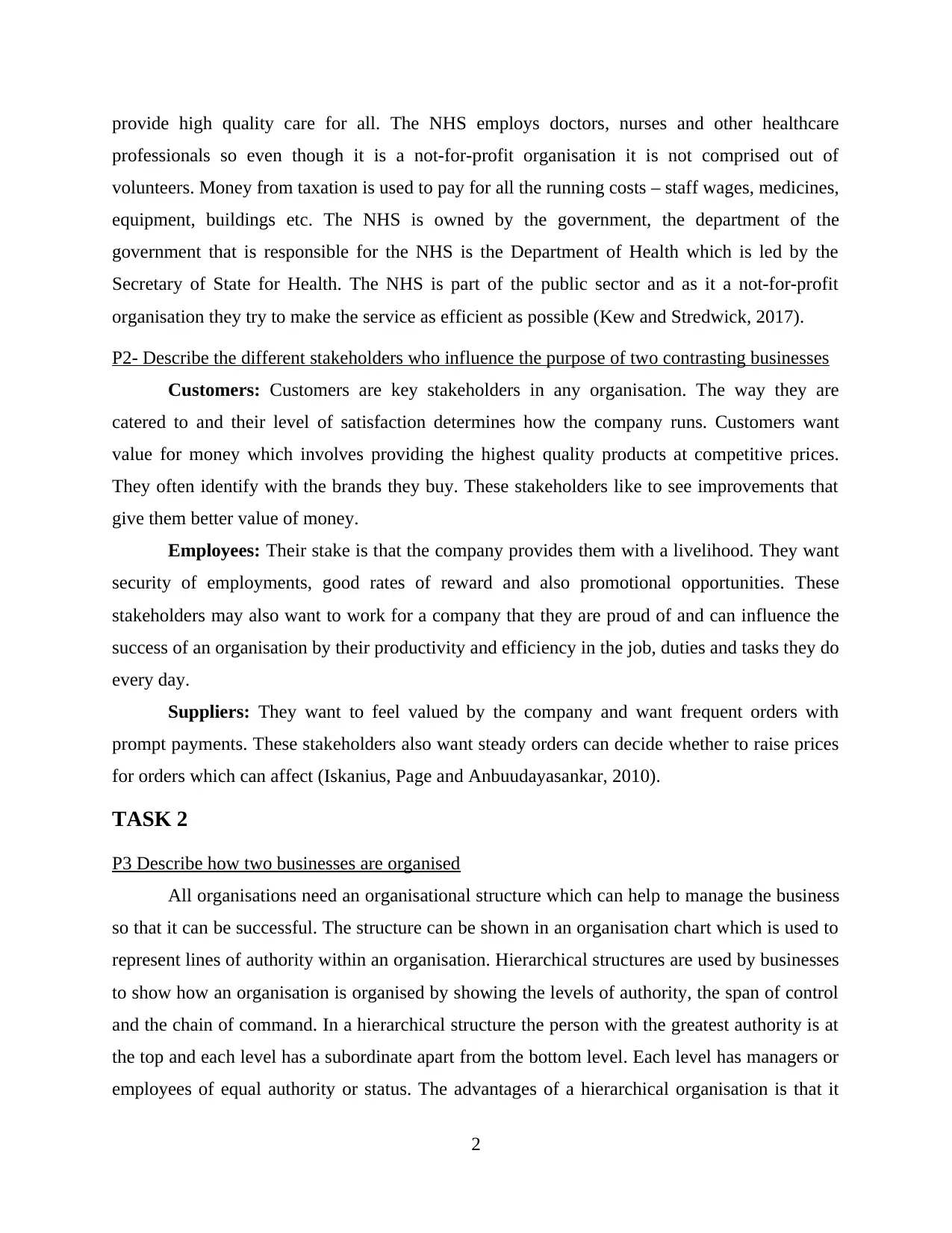
provide high quality care for all. The NHS employs doctors, nurses and other healthcare
professionals so even though it is a not-for-profit organisation it is not comprised out of
volunteers. Money from taxation is used to pay for all the running costs – staff wages, medicines,
equipment, buildings etc. The NHS is owned by the government, the department of the
government that is responsible for the NHS is the Department of Health which is led by the
Secretary of State for Health. The NHS is part of the public sector and as it a not-for-profit
organisation they try to make the service as efficient as possible (Kew and Stredwick, 2017).
P2- Describe the different stakeholders who influence the purpose of two contrasting businesses
Customers: Customers are key stakeholders in any organisation. The way they are
catered to and their level of satisfaction determines how the company runs. Customers want
value for money which involves providing the highest quality products at competitive prices.
They often identify with the brands they buy. These stakeholders like to see improvements that
give them better value of money.
Employees: Their stake is that the company provides them with a livelihood. They want
security of employments, good rates of reward and also promotional opportunities. These
stakeholders may also want to work for a company that they are proud of and can influence the
success of an organisation by their productivity and efficiency in the job, duties and tasks they do
every day.
Suppliers: They want to feel valued by the company and want frequent orders with
prompt payments. These stakeholders also want steady orders can decide whether to raise prices
for orders which can affect (Iskanius, Page and Anbuudayasankar, 2010).
TASK 2
P3 Describe how two businesses are organised
All organisations need an organisational structure which can help to manage the business
so that it can be successful. The structure can be shown in an organisation chart which is used to
represent lines of authority within an organisation. Hierarchical structures are used by businesses
to show how an organisation is organised by showing the levels of authority, the span of control
and the chain of command. In a hierarchical structure the person with the greatest authority is at
the top and each level has a subordinate apart from the bottom level. Each level has managers or
employees of equal authority or status. The advantages of a hierarchical organisation is that it
2
professionals so even though it is a not-for-profit organisation it is not comprised out of
volunteers. Money from taxation is used to pay for all the running costs – staff wages, medicines,
equipment, buildings etc. The NHS is owned by the government, the department of the
government that is responsible for the NHS is the Department of Health which is led by the
Secretary of State for Health. The NHS is part of the public sector and as it a not-for-profit
organisation they try to make the service as efficient as possible (Kew and Stredwick, 2017).
P2- Describe the different stakeholders who influence the purpose of two contrasting businesses
Customers: Customers are key stakeholders in any organisation. The way they are
catered to and their level of satisfaction determines how the company runs. Customers want
value for money which involves providing the highest quality products at competitive prices.
They often identify with the brands they buy. These stakeholders like to see improvements that
give them better value of money.
Employees: Their stake is that the company provides them with a livelihood. They want
security of employments, good rates of reward and also promotional opportunities. These
stakeholders may also want to work for a company that they are proud of and can influence the
success of an organisation by their productivity and efficiency in the job, duties and tasks they do
every day.
Suppliers: They want to feel valued by the company and want frequent orders with
prompt payments. These stakeholders also want steady orders can decide whether to raise prices
for orders which can affect (Iskanius, Page and Anbuudayasankar, 2010).
TASK 2
P3 Describe how two businesses are organised
All organisations need an organisational structure which can help to manage the business
so that it can be successful. The structure can be shown in an organisation chart which is used to
represent lines of authority within an organisation. Hierarchical structures are used by businesses
to show how an organisation is organised by showing the levels of authority, the span of control
and the chain of command. In a hierarchical structure the person with the greatest authority is at
the top and each level has a subordinate apart from the bottom level. Each level has managers or
employees of equal authority or status. The advantages of a hierarchical organisation is that it
2
Paraphrase This Document
Need a fresh take? Get an instant paraphrase of this document with our AI Paraphraser
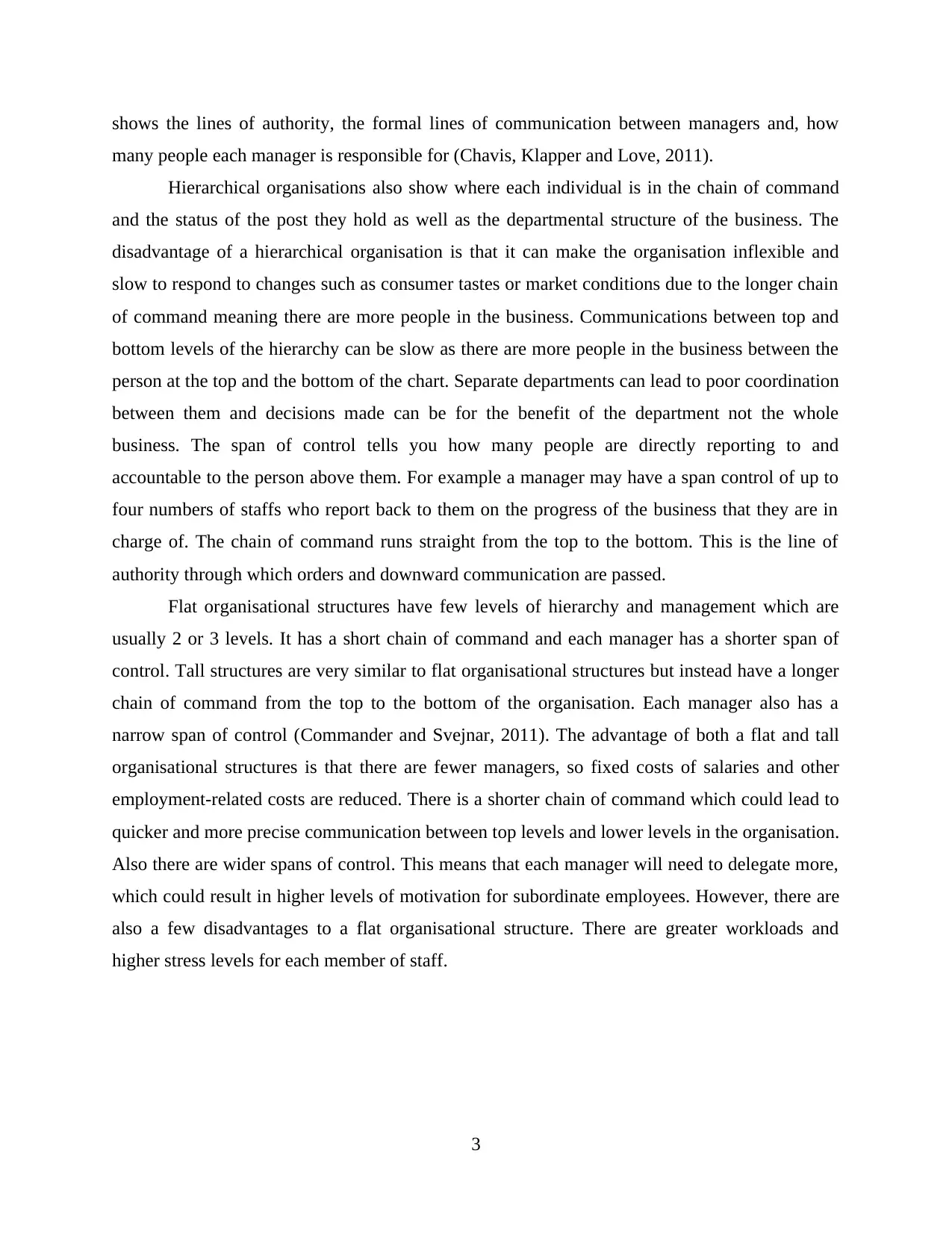
shows the lines of authority, the formal lines of communication between managers and, how
many people each manager is responsible for (Chavis, Klapper and Love, 2011).
Hierarchical organisations also show where each individual is in the chain of command
and the status of the post they hold as well as the departmental structure of the business. The
disadvantage of a hierarchical organisation is that it can make the organisation inflexible and
slow to respond to changes such as consumer tastes or market conditions due to the longer chain
of command meaning there are more people in the business. Communications between top and
bottom levels of the hierarchy can be slow as there are more people in the business between the
person at the top and the bottom of the chart. Separate departments can lead to poor coordination
between them and decisions made can be for the benefit of the department not the whole
business. The span of control tells you how many people are directly reporting to and
accountable to the person above them. For example a manager may have a span control of up to
four numbers of staffs who report back to them on the progress of the business that they are in
charge of. The chain of command runs straight from the top to the bottom. This is the line of
authority through which orders and downward communication are passed.
Flat organisational structures have few levels of hierarchy and management which are
usually 2 or 3 levels. It has a short chain of command and each manager has a shorter span of
control. Tall structures are very similar to flat organisational structures but instead have a longer
chain of command from the top to the bottom of the organisation. Each manager also has a
narrow span of control (Commander and Svejnar, 2011). The advantage of both a flat and tall
organisational structures is that there are fewer managers, so fixed costs of salaries and other
employment-related costs are reduced. There is a shorter chain of command which could lead to
quicker and more precise communication between top levels and lower levels in the organisation.
Also there are wider spans of control. This means that each manager will need to delegate more,
which could result in higher levels of motivation for subordinate employees. However, there are
also a few disadvantages to a flat organisational structure. There are greater workloads and
higher stress levels for each member of staff.
3
many people each manager is responsible for (Chavis, Klapper and Love, 2011).
Hierarchical organisations also show where each individual is in the chain of command
and the status of the post they hold as well as the departmental structure of the business. The
disadvantage of a hierarchical organisation is that it can make the organisation inflexible and
slow to respond to changes such as consumer tastes or market conditions due to the longer chain
of command meaning there are more people in the business. Communications between top and
bottom levels of the hierarchy can be slow as there are more people in the business between the
person at the top and the bottom of the chart. Separate departments can lead to poor coordination
between them and decisions made can be for the benefit of the department not the whole
business. The span of control tells you how many people are directly reporting to and
accountable to the person above them. For example a manager may have a span control of up to
four numbers of staffs who report back to them on the progress of the business that they are in
charge of. The chain of command runs straight from the top to the bottom. This is the line of
authority through which orders and downward communication are passed.
Flat organisational structures have few levels of hierarchy and management which are
usually 2 or 3 levels. It has a short chain of command and each manager has a shorter span of
control. Tall structures are very similar to flat organisational structures but instead have a longer
chain of command from the top to the bottom of the organisation. Each manager also has a
narrow span of control (Commander and Svejnar, 2011). The advantage of both a flat and tall
organisational structures is that there are fewer managers, so fixed costs of salaries and other
employment-related costs are reduced. There is a shorter chain of command which could lead to
quicker and more precise communication between top levels and lower levels in the organisation.
Also there are wider spans of control. This means that each manager will need to delegate more,
which could result in higher levels of motivation for subordinate employees. However, there are
also a few disadvantages to a flat organisational structure. There are greater workloads and
higher stress levels for each member of staff.
3
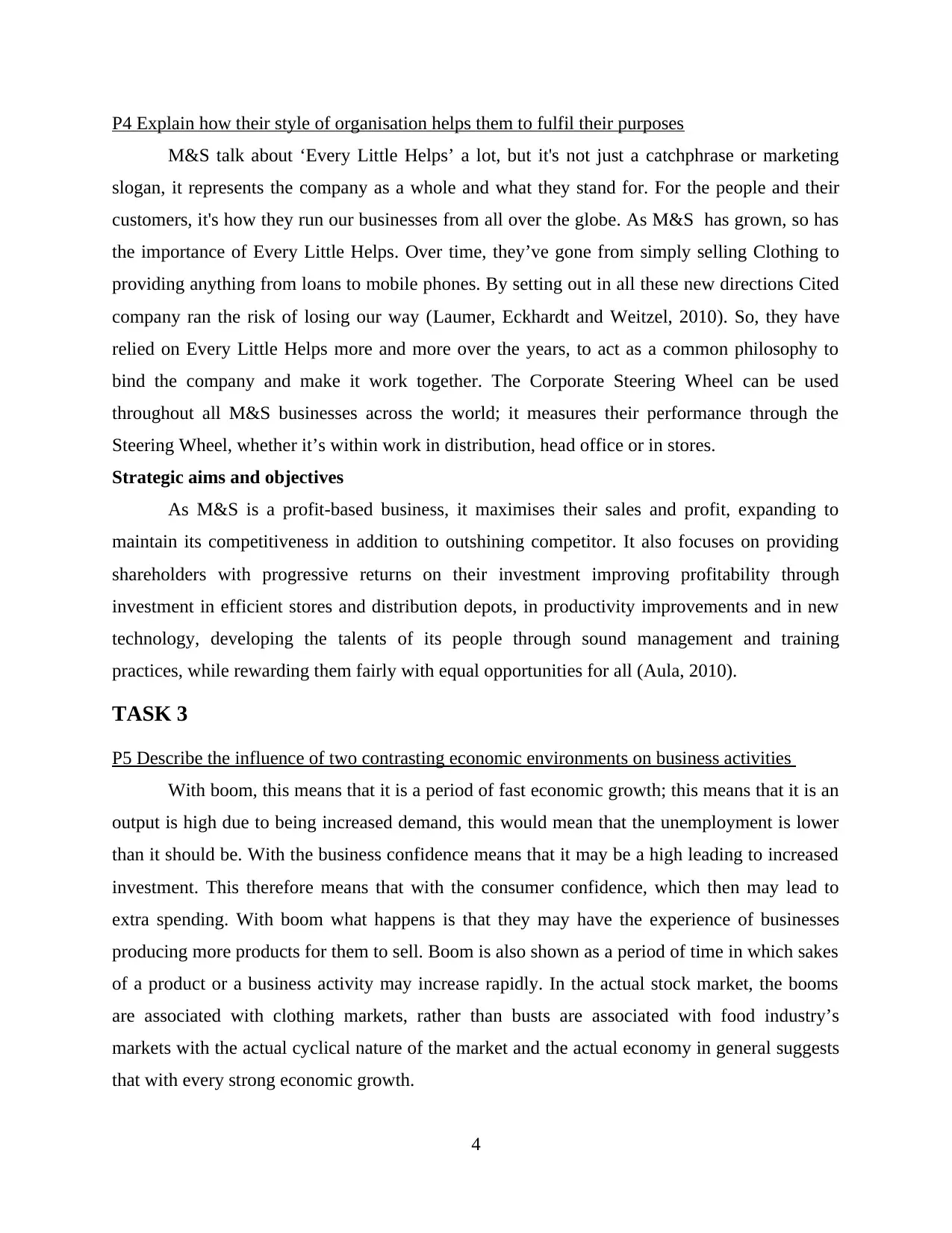
P4 Explain how their style of organisation helps them to fulfil their purposes
M&S talk about ‘Every Little Helps’ a lot, but it's not just a catchphrase or marketing
slogan, it represents the company as a whole and what they stand for. For the people and their
customers, it's how they run our businesses from all over the globe. As M&S has grown, so has
the importance of Every Little Helps. Over time, they’ve gone from simply selling Clothing to
providing anything from loans to mobile phones. By setting out in all these new directions Cited
company ran the risk of losing our way (Laumer, Eckhardt and Weitzel, 2010). So, they have
relied on Every Little Helps more and more over the years, to act as a common philosophy to
bind the company and make it work together. The Corporate Steering Wheel can be used
throughout all M&S businesses across the world; it measures their performance through the
Steering Wheel, whether it’s within work in distribution, head office or in stores.
Strategic aims and objectives
As M&S is a profit-based business, it maximises their sales and profit, expanding to
maintain its competitiveness in addition to outshining competitor. It also focuses on providing
shareholders with progressive returns on their investment improving profitability through
investment in efficient stores and distribution depots, in productivity improvements and in new
technology, developing the talents of its people through sound management and training
practices, while rewarding them fairly with equal opportunities for all (Aula, 2010).
TASK 3
P5 Describe the influence of two contrasting economic environments on business activities
With boom, this means that it is a period of fast economic growth; this means that it is an
output is high due to being increased demand, this would mean that the unemployment is lower
than it should be. With the business confidence means that it may be a high leading to increased
investment. This therefore means that with the consumer confidence, which then may lead to
extra spending. With boom what happens is that they may have the experience of businesses
producing more products for them to sell. Boom is also shown as a period of time in which sakes
of a product or a business activity may increase rapidly. In the actual stock market, the booms
are associated with clothing markets, rather than busts are associated with food industry’s
markets with the actual cyclical nature of the market and the actual economy in general suggests
that with every strong economic growth.
4
M&S talk about ‘Every Little Helps’ a lot, but it's not just a catchphrase or marketing
slogan, it represents the company as a whole and what they stand for. For the people and their
customers, it's how they run our businesses from all over the globe. As M&S has grown, so has
the importance of Every Little Helps. Over time, they’ve gone from simply selling Clothing to
providing anything from loans to mobile phones. By setting out in all these new directions Cited
company ran the risk of losing our way (Laumer, Eckhardt and Weitzel, 2010). So, they have
relied on Every Little Helps more and more over the years, to act as a common philosophy to
bind the company and make it work together. The Corporate Steering Wheel can be used
throughout all M&S businesses across the world; it measures their performance through the
Steering Wheel, whether it’s within work in distribution, head office or in stores.
Strategic aims and objectives
As M&S is a profit-based business, it maximises their sales and profit, expanding to
maintain its competitiveness in addition to outshining competitor. It also focuses on providing
shareholders with progressive returns on their investment improving profitability through
investment in efficient stores and distribution depots, in productivity improvements and in new
technology, developing the talents of its people through sound management and training
practices, while rewarding them fairly with equal opportunities for all (Aula, 2010).
TASK 3
P5 Describe the influence of two contrasting economic environments on business activities
With boom, this means that it is a period of fast economic growth; this means that it is an
output is high due to being increased demand, this would mean that the unemployment is lower
than it should be. With the business confidence means that it may be a high leading to increased
investment. This therefore means that with the consumer confidence, which then may lead to
extra spending. With boom what happens is that they may have the experience of businesses
producing more products for them to sell. Boom is also shown as a period of time in which sakes
of a product or a business activity may increase rapidly. In the actual stock market, the booms
are associated with clothing markets, rather than busts are associated with food industry’s
markets with the actual cyclical nature of the market and the actual economy in general suggests
that with every strong economic growth.
4
⊘ This is a preview!⊘
Do you want full access?
Subscribe today to unlock all pages.

Trusted by 1+ million students worldwide
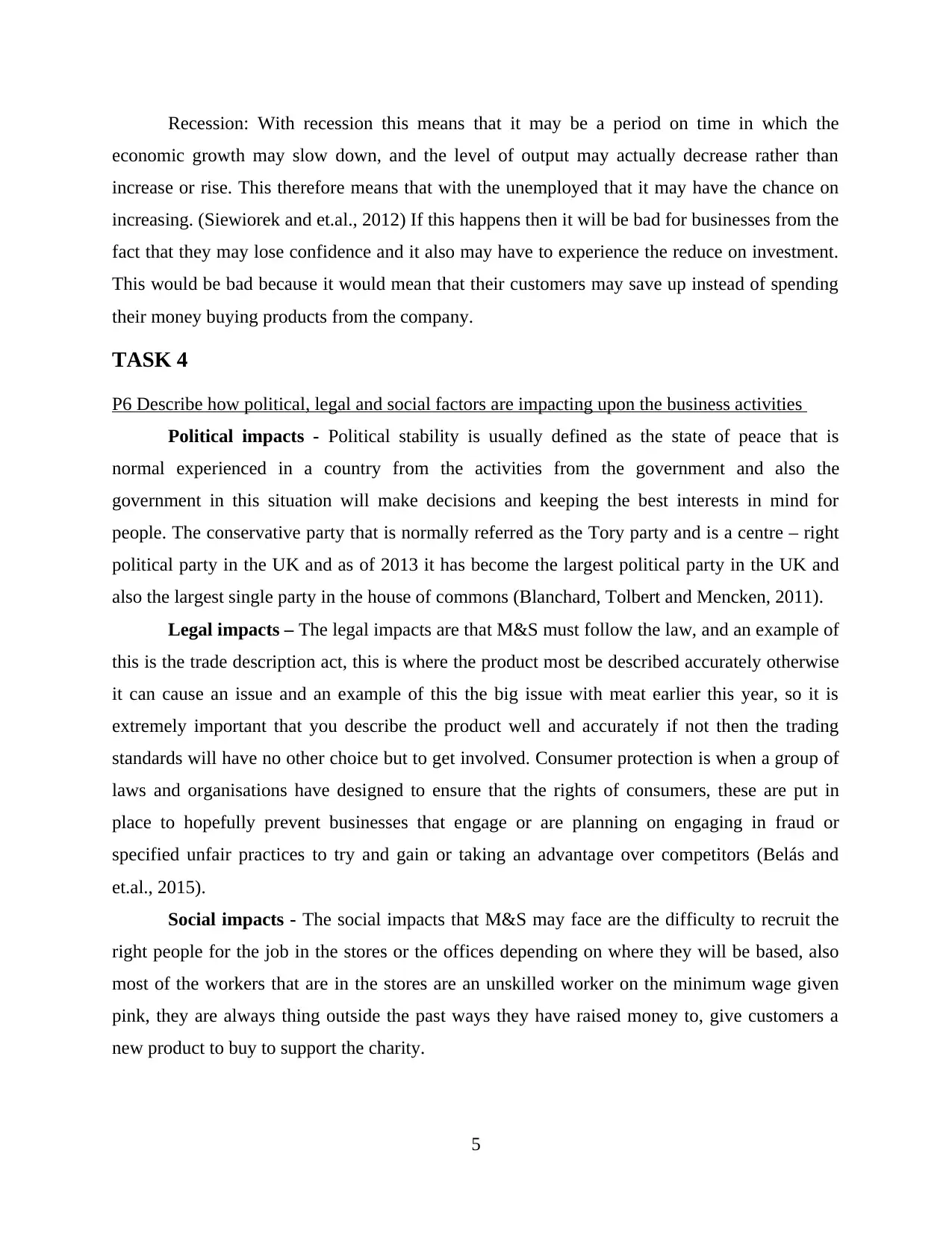
Recession: With recession this means that it may be a period on time in which the
economic growth may slow down, and the level of output may actually decrease rather than
increase or rise. This therefore means that with the unemployed that it may have the chance on
increasing. (Siewiorek and et.al., 2012) If this happens then it will be bad for businesses from the
fact that they may lose confidence and it also may have to experience the reduce on investment.
This would be bad because it would mean that their customers may save up instead of spending
their money buying products from the company.
TASK 4
P6 Describe how political, legal and social factors are impacting upon the business activities
Political impacts - Political stability is usually defined as the state of peace that is
normal experienced in a country from the activities from the government and also the
government in this situation will make decisions and keeping the best interests in mind for
people. The conservative party that is normally referred as the Tory party and is a centre – right
political party in the UK and as of 2013 it has become the largest political party in the UK and
also the largest single party in the house of commons (Blanchard, Tolbert and Mencken, 2011).
Legal impacts – The legal impacts are that M&S must follow the law, and an example of
this is the trade description act, this is where the product most be described accurately otherwise
it can cause an issue and an example of this the big issue with meat earlier this year, so it is
extremely important that you describe the product well and accurately if not then the trading
standards will have no other choice but to get involved. Consumer protection is when a group of
laws and organisations have designed to ensure that the rights of consumers, these are put in
place to hopefully prevent businesses that engage or are planning on engaging in fraud or
specified unfair practices to try and gain or taking an advantage over competitors (Belás and
et.al., 2015).
Social impacts - The social impacts that M&S may face are the difficulty to recruit the
right people for the job in the stores or the offices depending on where they will be based, also
most of the workers that are in the stores are an unskilled worker on the minimum wage given
pink, they are always thing outside the past ways they have raised money to, give customers a
new product to buy to support the charity.
5
economic growth may slow down, and the level of output may actually decrease rather than
increase or rise. This therefore means that with the unemployed that it may have the chance on
increasing. (Siewiorek and et.al., 2012) If this happens then it will be bad for businesses from the
fact that they may lose confidence and it also may have to experience the reduce on investment.
This would be bad because it would mean that their customers may save up instead of spending
their money buying products from the company.
TASK 4
P6 Describe how political, legal and social factors are impacting upon the business activities
Political impacts - Political stability is usually defined as the state of peace that is
normal experienced in a country from the activities from the government and also the
government in this situation will make decisions and keeping the best interests in mind for
people. The conservative party that is normally referred as the Tory party and is a centre – right
political party in the UK and as of 2013 it has become the largest political party in the UK and
also the largest single party in the house of commons (Blanchard, Tolbert and Mencken, 2011).
Legal impacts – The legal impacts are that M&S must follow the law, and an example of
this is the trade description act, this is where the product most be described accurately otherwise
it can cause an issue and an example of this the big issue with meat earlier this year, so it is
extremely important that you describe the product well and accurately if not then the trading
standards will have no other choice but to get involved. Consumer protection is when a group of
laws and organisations have designed to ensure that the rights of consumers, these are put in
place to hopefully prevent businesses that engage or are planning on engaging in fraud or
specified unfair practices to try and gain or taking an advantage over competitors (Belás and
et.al., 2015).
Social impacts - The social impacts that M&S may face are the difficulty to recruit the
right people for the job in the stores or the offices depending on where they will be based, also
most of the workers that are in the stores are an unskilled worker on the minimum wage given
pink, they are always thing outside the past ways they have raised money to, give customers a
new product to buy to support the charity.
5
Paraphrase This Document
Need a fresh take? Get an instant paraphrase of this document with our AI Paraphraser
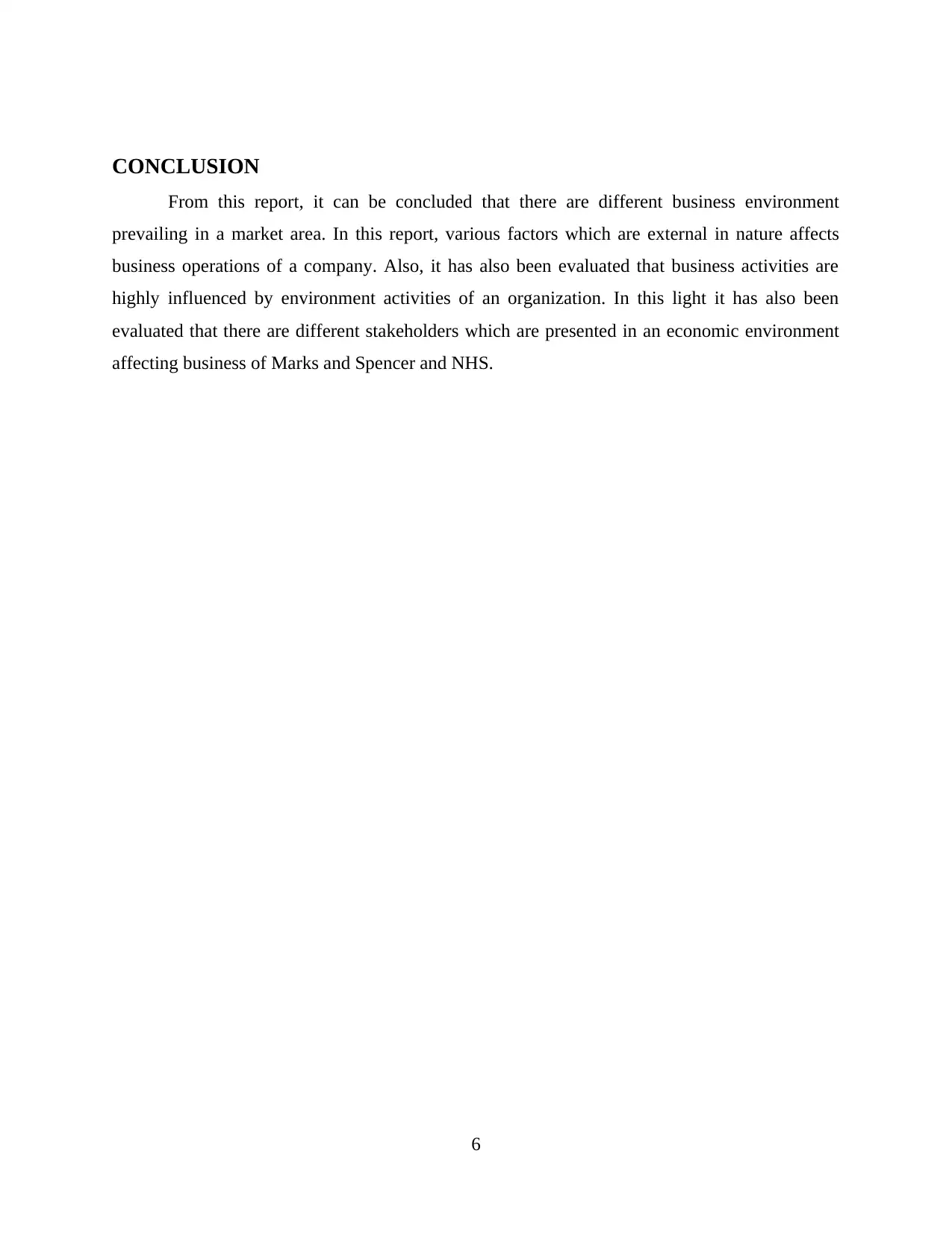
CONCLUSION
From this report, it can be concluded that there are different business environment
prevailing in a market area. In this report, various factors which are external in nature affects
business operations of a company. Also, it has also been evaluated that business activities are
highly influenced by environment activities of an organization. In this light it has also been
evaluated that there are different stakeholders which are presented in an economic environment
affecting business of Marks and Spencer and NHS.
6
From this report, it can be concluded that there are different business environment
prevailing in a market area. In this report, various factors which are external in nature affects
business operations of a company. Also, it has also been evaluated that business activities are
highly influenced by environment activities of an organization. In this light it has also been
evaluated that there are different stakeholders which are presented in an economic environment
affecting business of Marks and Spencer and NHS.
6
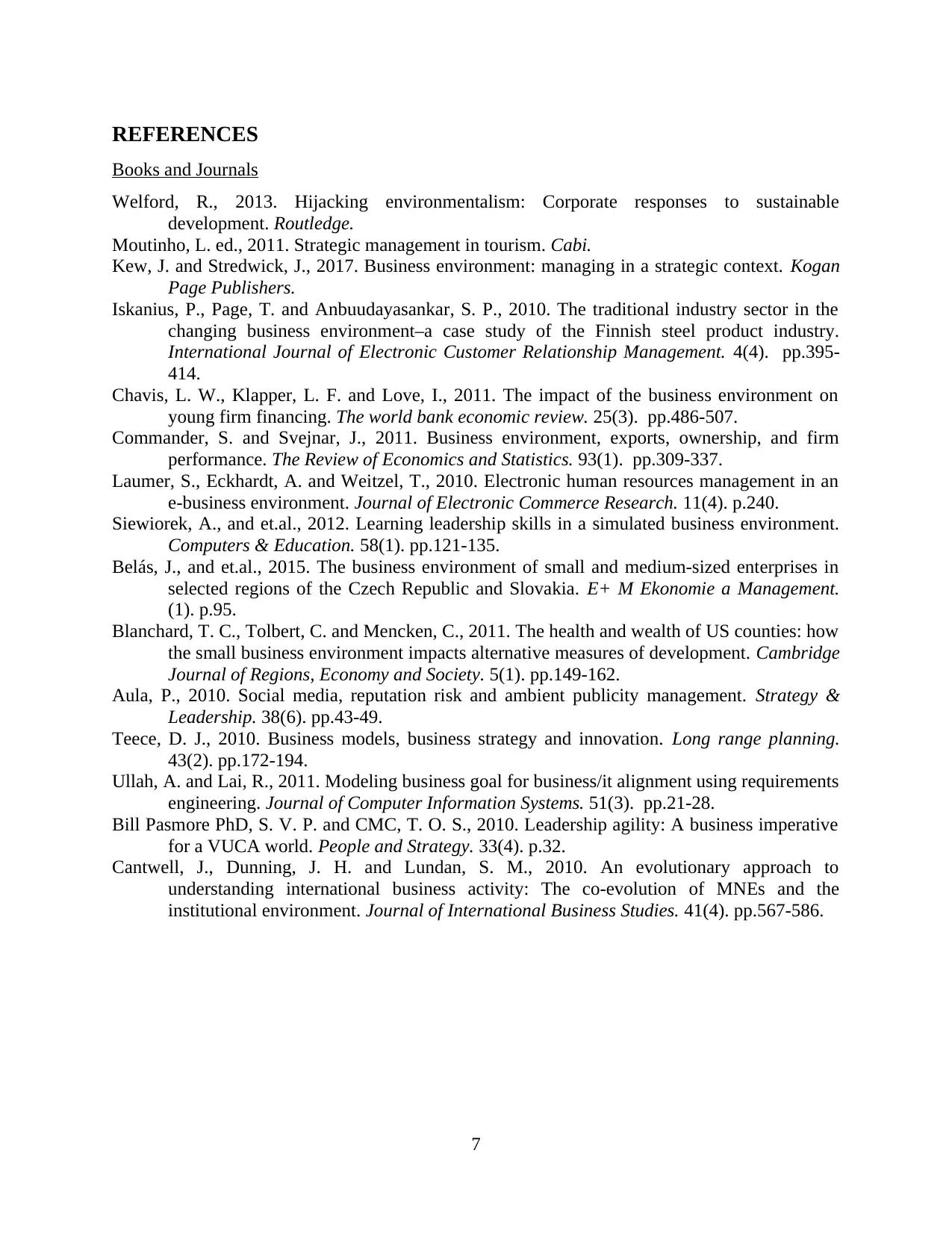
REFERENCES
Books and Journals
Welford, R., 2013. Hijacking environmentalism: Corporate responses to sustainable
development. Routledge.
Moutinho, L. ed., 2011. Strategic management in tourism. Cabi.
Kew, J. and Stredwick, J., 2017. Business environment: managing in a strategic context. Kogan
Page Publishers.
Iskanius, P., Page, T. and Anbuudayasankar, S. P., 2010. The traditional industry sector in the
changing business environment–a case study of the Finnish steel product industry.
International Journal of Electronic Customer Relationship Management. 4(4). pp.395-
414.
Chavis, L. W., Klapper, L. F. and Love, I., 2011. The impact of the business environment on
young firm financing. The world bank economic review. 25(3). pp.486-507.
Commander, S. and Svejnar, J., 2011. Business environment, exports, ownership, and firm
performance. The Review of Economics and Statistics. 93(1). pp.309-337.
Laumer, S., Eckhardt, A. and Weitzel, T., 2010. Electronic human resources management in an
e-business environment. Journal of Electronic Commerce Research. 11(4). p.240.
Siewiorek, A., and et.al., 2012. Learning leadership skills in a simulated business environment.
Computers & Education. 58(1). pp.121-135.
Belás, J., and et.al., 2015. The business environment of small and medium-sized enterprises in
selected regions of the Czech Republic and Slovakia. E+ M Ekonomie a Management.
(1). p.95.
Blanchard, T. C., Tolbert, C. and Mencken, C., 2011. The health and wealth of US counties: how
the small business environment impacts alternative measures of development. Cambridge
Journal of Regions, Economy and Society. 5(1). pp.149-162.
Aula, P., 2010. Social media, reputation risk and ambient publicity management. Strategy &
Leadership. 38(6). pp.43-49.
Teece, D. J., 2010. Business models, business strategy and innovation. Long range planning.
43(2). pp.172-194.
Ullah, A. and Lai, R., 2011. Modeling business goal for business/it alignment using requirements
engineering. Journal of Computer Information Systems. 51(3). pp.21-28.
Bill Pasmore PhD, S. V. P. and CMC, T. O. S., 2010. Leadership agility: A business imperative
for a VUCA world. People and Strategy. 33(4). p.32.
Cantwell, J., Dunning, J. H. and Lundan, S. M., 2010. An evolutionary approach to
understanding international business activity: The co-evolution of MNEs and the
institutional environment. Journal of International Business Studies. 41(4). pp.567-586.
7
Books and Journals
Welford, R., 2013. Hijacking environmentalism: Corporate responses to sustainable
development. Routledge.
Moutinho, L. ed., 2011. Strategic management in tourism. Cabi.
Kew, J. and Stredwick, J., 2017. Business environment: managing in a strategic context. Kogan
Page Publishers.
Iskanius, P., Page, T. and Anbuudayasankar, S. P., 2010. The traditional industry sector in the
changing business environment–a case study of the Finnish steel product industry.
International Journal of Electronic Customer Relationship Management. 4(4). pp.395-
414.
Chavis, L. W., Klapper, L. F. and Love, I., 2011. The impact of the business environment on
young firm financing. The world bank economic review. 25(3). pp.486-507.
Commander, S. and Svejnar, J., 2011. Business environment, exports, ownership, and firm
performance. The Review of Economics and Statistics. 93(1). pp.309-337.
Laumer, S., Eckhardt, A. and Weitzel, T., 2010. Electronic human resources management in an
e-business environment. Journal of Electronic Commerce Research. 11(4). p.240.
Siewiorek, A., and et.al., 2012. Learning leadership skills in a simulated business environment.
Computers & Education. 58(1). pp.121-135.
Belás, J., and et.al., 2015. The business environment of small and medium-sized enterprises in
selected regions of the Czech Republic and Slovakia. E+ M Ekonomie a Management.
(1). p.95.
Blanchard, T. C., Tolbert, C. and Mencken, C., 2011. The health and wealth of US counties: how
the small business environment impacts alternative measures of development. Cambridge
Journal of Regions, Economy and Society. 5(1). pp.149-162.
Aula, P., 2010. Social media, reputation risk and ambient publicity management. Strategy &
Leadership. 38(6). pp.43-49.
Teece, D. J., 2010. Business models, business strategy and innovation. Long range planning.
43(2). pp.172-194.
Ullah, A. and Lai, R., 2011. Modeling business goal for business/it alignment using requirements
engineering. Journal of Computer Information Systems. 51(3). pp.21-28.
Bill Pasmore PhD, S. V. P. and CMC, T. O. S., 2010. Leadership agility: A business imperative
for a VUCA world. People and Strategy. 33(4). p.32.
Cantwell, J., Dunning, J. H. and Lundan, S. M., 2010. An evolutionary approach to
understanding international business activity: The co-evolution of MNEs and the
institutional environment. Journal of International Business Studies. 41(4). pp.567-586.
7
⊘ This is a preview!⊘
Do you want full access?
Subscribe today to unlock all pages.

Trusted by 1+ million students worldwide
1 out of 9
Related Documents
Your All-in-One AI-Powered Toolkit for Academic Success.
+13062052269
info@desklib.com
Available 24*7 on WhatsApp / Email
![[object Object]](/_next/static/media/star-bottom.7253800d.svg)
Unlock your academic potential
Copyright © 2020–2025 A2Z Services. All Rights Reserved. Developed and managed by ZUCOL.





